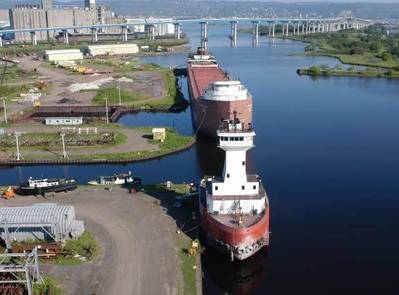U.S.-flag Great Lakes vessel operators plan to spend $75 million this winter to ready the fleet for the 2015 shipping season, the Lake Carriers’ Association (LCA) reported. One vessel is already in drydock undergoing the out-of-water hull inspection required by U.S. law every five years. The remainder of the fleet will arrive at their winter berths in early to mid-January.
The $75 million to be spent this winter comes on top of the nearly $6 million required in April and May to repair damages suffered trying to meet the needs of commerce when heavy ice blanketed the Lakes last winter and spring.
The work to be performed stretches from bow to stern. Main engines, which run virtually nonstop from spring fit-out to winter lay-up, will be overhauled. The largest engines on U.S.-flag lakers are capable of generating nearly 20,000 horsepower.
All the U.S.-flag lakers in service this year were self-unloaders and a number of conveyor belts that move the cargo from the holds to the unloading boom will be replaced.
Some cargo holds will be relined with plastic to facilitate the unloading of sticky cargos such as certain coals. One ship will have all 24 cargo hatch covers replaced for the first time since its christening in 1976. With the Lakes being a freshwater environment, longevity is a hallmark of the fleet.
Navigation, fire fighting and lifesaving equipment will also be carefully checked and replaced or upgraded as necessary.
The major shipyards on the Lakes are located in Sturgeon Bay, Superior and Marinette, Wisconsin; Erie, Pennsylvania; and Toledo, Ohio. Smaller topside repair operations are located in Cleveland, Ohio; Escanaba, Michigan; Buffalo, New York; and several cities in Michigan. The industry’s annual payroll for its 2,700 employees approaches $125 million and it is estimated that an additional $800,000 in economic activity is generated per vessel in the community in which it is wintering.
Maintaining the Lakes fleet this winter will require precise planning and coordination by the shipyards. This is a very busy period for Great Lakes shipyards. Several yards are actively engaged in commercial and military construction. In fact, one yard has a nine-vessel backlog that extends into 2017.
Also in the offing are potential conversions of lakers to be fueled with LNG.













